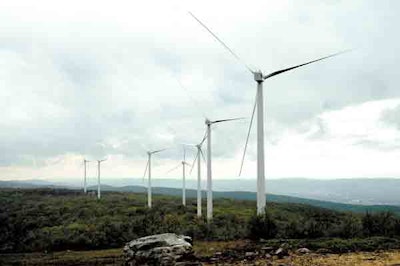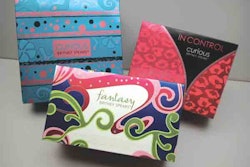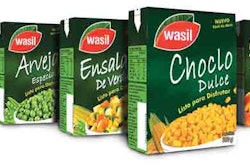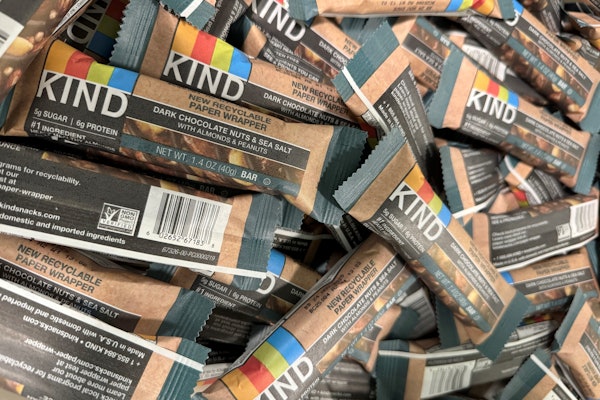Sustainable Packaging goes mainstream this month as 60,000 Wal-Mart suppliers begin entering information on the Wal-Mart Sustainable Packaging Scorecard. Rankings will show suppliers how well their packaging stacks up against the competition in terms of:
• Greenhouse gases emitted during manufacture
• Environmentally friendly materials
• Product-to-package ratio
• Cube utilization
• Transportation impacts
• Recycled content
• Recovery value
• Renewable energy used
• Sustainable innovations
“The breadth of the Wal-Mart initiative is precedent setting,” says Anne Johnson, director of the Sustainable Packaging Coalition, a project of GreenBlue. “The initiative will help to promote sustainable practices across all segments of the packaged goods supply chain.”
In February 2008, Wal-Mart buyers will begin factoring scorecard results into their purchasing decisions. What factors led Wal-Mart to make such a dramatic and far-reaching move? How much weight will buyers give to sustainability rankings? What will this mean for Consumer Package Goods (CPG) companies in terms of cost of packaging? Only time will tell.
One thing we do know is that Wal-Mart has been methodical in its approach to sustainable packaging. CEO Lee Scott and his senior management team spent a year listening to customers, employees, citizen groups, government leaders, and other organizations. The management team came to the realization that because of its size and scope, Wal-Mart is uniquely positioned to have an impact on the world like no company before it.
Scott talked to employees about packaging. He asked in October 2005, “Have you ever noticed that when you’ve taken the item out of the package you’ve got more packaging than item? We want to ensure that our goods come in the right size package, and we want to ensure that the materials in that packaging are made from renewable or recyclable materials that can make future packages. Pretty simple, really. And it saves us a lot of money.”
At the 2006 Clinton Global Initiative, Wal-Mart committed to reducing packaging by five percent across its supply chain by 2013. The company estimates that it will save approximately $3.4 billion from the reduction and that the total global savings across the supply chain will exceed $10 billion.
What factors will contribute to these savings? Wal-Mart believes that improving packaging sustainability results in less waste, fewer materials used, and savings in manufacturing, transportation, storage, and disposal/recovery. For example, working with its private-label suppliers, Wal-Mart reduced the packaging on 300 SKUs of its Kid Connection toy line. This allowed the company to:
• Reduce the amount of corrugated materials by 3,425 tons
• Use 1,358 fewer gallons of oil
• Eliminate 727 shipping containers
• Cut $3.5 million in shipping costs
This savings came from just 300 SKUs. Scott is now challenging suppliers to create packaging success stories for all of the more than 160,000 products on Wal-Mart shelves.
Said Scott, “There is a simple rule about the environment, and that is if there is waste or pollution someone along the line pays for it.” The Wal-Mart vision for sustainable packaging is an effort to cut waste and pollution, which will in turn reduce overhead, improve the bottom line, and contribute to a better tomorrow.
“Being a good steward of the environment and our communities, and being an efficient and profitable business, are not mutually exclusive,” Scott stated. “In fact they are one and the same.”
Sustainability by the numbers
There are two features about the packaging scorecard (www.scorecardlibrary.com) that are important for companies in the supply chain to grasp:
• The scorecard is based on a life-cycle view of a sustainable package—from raw materials to conversion, transportation, and disposal/recovery.
• There are no mandates.
These two facts mean that CPG companies can pick and chose at what points along the life cycle of the package they want to apply innovations—innovations that make sense from a business perspective. Wal-Mart is making life-cycle modeling software available for just that reason. (The software is available for a $900 per-year subscription fee.) Package designers can plug in different variables and see the impact their choices have on the overall sustainability score.
“A life cycle perspective is essential for a comprehensive evaluation of the sustainability of a package,” says Johnson of the Sustainable Packaging Coalition. “You have to look at impacts from raw material extraction all the way through all probable end-of-life scenarios.”
Johnson emphasizes that this is a different way of thinking for most companies, since traditionally they have designed for cost, performance, and aesthetics. Now companies are being asked to design packaging for total quality throughout the life cycle.
Will this effort necessarily add costs? “Given the technology, materials, and options available today, I believe our suppliers are going to innovate, reduce life cycle impact, and come out with overall savings,” says Matt Kistler, vice president of packaging and production innovations for SAM’s Club. “We cannot disrupt the financial position of our suppliers.”
During a keynote presentation at Pack Expo International in Chicago, co-delivered by Kistler and Amy Zettlemoyer, director of packaging at SAM’s Club, an audience member asked how much weight Wal-Mart buyers would give to sustainability scores. “I can see a higher sustainability score being a tie breaker in a dead heat,” Kistler answered. “But there will not be some magic formula that says here are the financials and the scorecard ranking, and this is our decision. That does not exist and I don’t see that it ever will. The packaging scorecard simply gives our buyers an additional decision-making tool—another fact to take into consideration.”
Slimming down
“Looking for opportunities to reduce the amount of material in a package is sound environmental practice,” says David Allaway, waste prevention specialist, Oregon Department of Environmental Quality (DEQ). “Reduction is at the head of the Environmental Protection Agency’s waste management hierarchy: reduce, reuse, recycle, compost, and recover energy.”
DEQ commissioned Franklin Associates to perform a life-cycle analysis comparing various solutions for shipping non-breakable items from Oregon to the Midwest. The study, (www.deq.state.or.us/wmc/packaging/other/index.htm), compared corrugated boxes with various loose-fill packing against bags made from kraft paper and/or poly material combinations.
In almost every one of the 80 categories considered in the life-cycle analysis, all ten shipping bags in the study, whether or not the materials were renewable or recyclable, had lower environmental burdens than corrugated boxes with loose-fill. The heaviest box and loose-fill combination—both materials were recyclable and contained post consumer content—weighed 26 times more than the lightest LLDPE bag.
The bags consumed less energy and generated fewer pollutants during manufacture, transportation, and disposal. Bags put less material into the waste stream.
“The study concluded that the weight of the material used was the critical factor and that ‘recycled content’ and ‘recyclable’ are not always the best predictors of life cycle energy use or emissions,” says Allaway. “The study also pointed out that once a material has been chosen based on lowest environmental burden, then increasing post-consumer content and increasing recycling opportunities can have benefits.”
Norm Thompson, an Oregon-based catalog and Web retailer, calculates that it saves approximately $1,154,000 annually in materials cost, labor, and shipping by using lightweight LLDPE bags rather than heavier corrugated boxes with loose-fill for shipping non-breakable items to customers. The savings of non-renewable energy is roughly equivalent to 110,000 gallons of gasoline. The reduction of greenhouse gas emissions is in excess of 1,100 metric tons of carbon dioxide per year, about the same benefit as removing 210 passenger cars from the road. There is a reduction of 627 tons of packaging materials when LLDPE bags rather than corrugated boxes and fill materials are utilized.
“When most people hear about sustainable packaging for the first time, they envision renewable materials and recycling as the attributes needed to achieve sustainability,” says Patty Enneking, director of global sustainability and environmental affairs, Klöckner Pentaplast. “The optimum solution for a packaging application may not include a renewable or recyclable material, as the DEQ study for shipping non-breakables indicates.”
Enneking says Wal-Mart’s scorecard raises industry-wide awareness that application optimization happens across a broad set of criteria—choice of material, product-to-package ratio, cube utilization, emissions, and energy consumption. There are no always right- or always-wrong—black or white—solutions to these issues. Experts suggest that companies should have a “palette of strategies” for moving toward sustainable packaging.
Getting started on the journey to sustainability
Given the scope of Wal-Mart’s program and the depth of the company’s commitment, it is clear that the packaging industry is going to be profoundly changed in its attitudes and understanding of sustainable practices. How can those companies not already involved in this effort begin?
One of the first and easiest steps for those just starting the journey would be to review the 2006 Packaging World series on sustainable packaging. The series provides an overview on sustainability—what is it and how to get started.
Investigate membership in The Sustainable Packaging Coalition, a project of GreenBlue (www.sustainablepackaging.org). This industry working group dedicates itself to transforming packaging into a system that encourages economic prosperity and a sustainable flow of materials. Packaging Strategies (www.packstrat.com) hosts an annual forum on sustainable packaging.
Wal-Mart has developed an online trade show (www.marketgate.com/packaging) where CPG companies will find information on consultants and materials and machinery suppliers that have something to offer in terms of sustainability. Wal-Mart plans to have every vendor in the virtual trade show certified by an independent source. CPG companies, regardless of whether or not they are suppliers to Wal-Mart, can access the virtual trade show during 2007 for a $300 subscription fee. In subsequent years, the annual fee will be $900. Educators, retailers, and both governmental and non-governmental groups have free access.
The Sustainable Packaging Coalition’s Johnson advises that companies begin by benchmarking a package or family of packages in terms of materials content, resource intensity, energy/water usage, waste generation, and air emissions, including greenhouse gases. She says, “You have to know where you are before you can begin charting a course toward improved sustainability.”
Many companies have been making progress toward sustainable packaging for years. These organizations know there are no absolutes. They understand that no one product, process, consultant, or company can claim to produce a thoroughly sustainable package or offer a one-size fits all solution.
There is one fact, however, that someday most people will probably agree on—that 2007 was year the world’s largest company helped the retail industry pause and consider the challenges and opportunities ahead along the road to sustainable packaging.

























